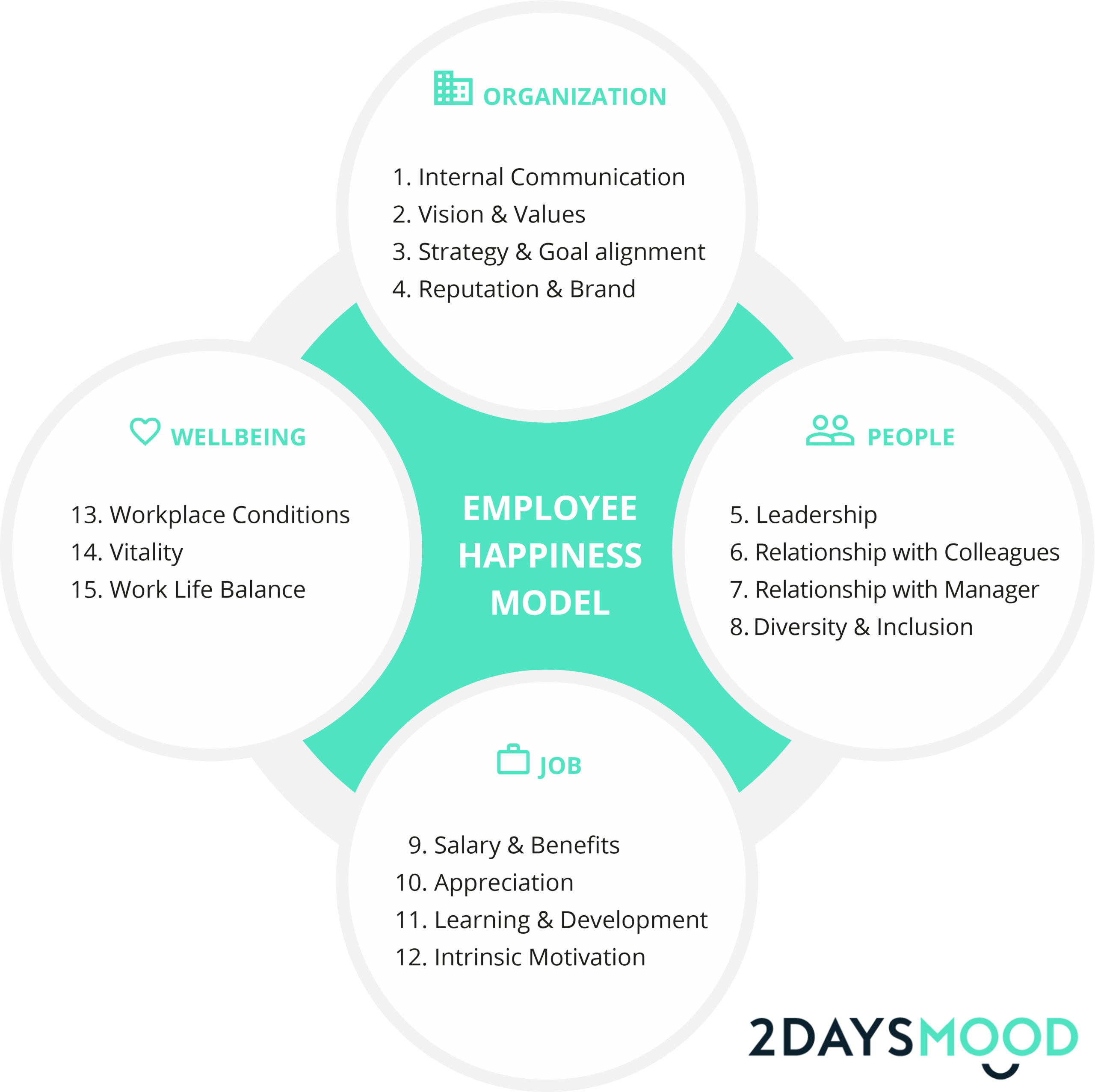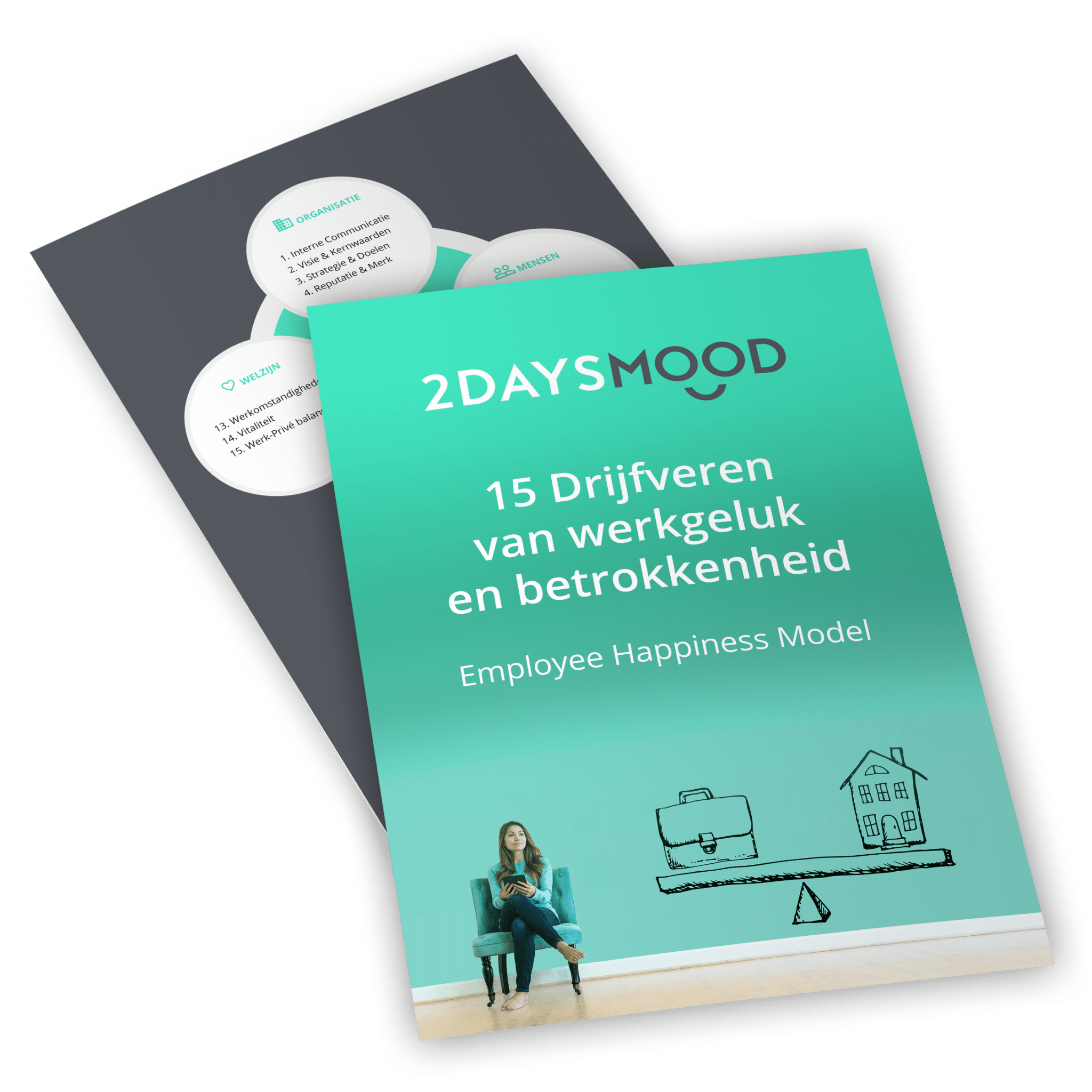The Employee Happiness Model: 15 crucial building blocks for employee engagement and workplace happiness
Engaged and happy employees are a golden formula for a successful organization. They work with infectious energy and productivity, and they create happy customers! But how do you make employees more engaged? With the Employee Happiness Model and our quick measurement method, you can take a data-driven approach.

A validated model
You can't just increase workplace happiness or engagement. It's a shared responsibility within the organization and requires regular attention. So where should you start as an HR manager, executive, or team?
2DAYSMOOD, in collaboration with Utrecht University, researched the universal factors that contribute to employee engagement and workplace happiness. From our findings, we developed the Employee Happiness Model®, which consists of 15 measurable drivers of workplace happiness.
Our quick surveys provide continuous insight into the status and priority of each driver at every level in your organization. This way, you know exactly where to start improving.
Organization
1. Internal communication
Internal communication is a determining factor for employee engagement and workplace happiness. Through communication within an organization, with and between employees, shared knowledge, values, and meaning are created. High-quality internal communication also helps cultivate positive relationships in the workplace (Karanges et al., 2014).
2. Vision and core values
The vision and core values of an organization are determining factors for employee engagement and workplace happiness. They represent the guidelines of the company's ethics, showing how the organization sees itself now and in the future. Employees want to identify with these to feel at home at work.
3. Strategy and goals
The strategy and goals of an organization are determining factors for employee engagement and workplace happiness. It is important that they are known and understood. An employee will feel more engaged with a company if the strategy and overall objectives align with their individual goals. Understanding task distribution and how individual work contributes to the bigger picture is also crucial.
4. Reputation and brand
Reputation and brand are determining factors for employee engagement and workplace happiness. Reputation describes the impression that internal and external stakeholders have of an organization, based on its past and future behavior. Through its brand, the organization can create a positive image associated with trust, quality, and customer satisfaction.
People
5. Leadership
Leadership is a determining factor for employee engagement and workplace happiness. Leaders are responsible for building the foundations of the organization, including a culture where employees can flourish. They should be a source of inspiration, enabling employees to work productively and passionately. Additionally, they must translate the company's vision, core values, strategy, and goals into understandable projects and tasks.
6. Relationship with colleagues
The relationship with colleagues is a determining factor for employee engagement and workplace happiness. Social relationships at work shape how individuals and teams can collaborate and achieve goals. This driver examines whether the factors of positive social interactions are present, such as pleasant communication, trust, mutual respect, and a shared sense of commitment within the team.
7. Relationship with manager
The relationship with the direct manager is a determining factor for employee engagement and workplace happiness. It's important for a manager to not only be a role model but also to understand why people work the way they do. Managers who show personal interest and trust in their employees can expect outstanding performance.
8. Diversity and inclusion
Diversity and inclusion play a crucial role in increasing employee engagement and workplace happiness. These aspects are closely linked to psycho social safety within an organization and how well it cares for the mental health of its staff. When employees are given the space to share their true selves, including their talents, motivations, and doubts, their engagement and loyalty to the organization are strengthened.
Job
9. Salary and benefits
Salary and benefits are determining factors for employee engagement and workplace happiness. Employees expect their salary to cover living expenses, allow for savings or recreation, and offer potential for increases. Benefits refer to non-monetary compensation. Increasingly, employees desire specific benefits, such as training opportunities and a healthy work-life balance.
10. Appreciation
Appreciation is a determining factor for employee engagement and workplace happiness. It is the positive emotional reward people receive for their effort and hard work, from their direct managers, colleagues, and other members of the organization. Appreciation is non-monetary and remains important throughout the entire employee lifecycle.
11. Learning and development
Training and development are determining factors for employee engagement and workplace happiness. They not only contribute to employees' sense of purpose but also help organizations create internal talent. The right amount of training and development enables successful execution of strategies. It encompasses all learning initiatives that allow employees to grow in their roles and within the organization.
12. Intrinsic motivation
Intrinsic motivation is a determining factor for employee engagement and workplace happiness. This driver describes the extent to which an employee perceives their work as valuable. Intrinsic motivation is influenced by a few essential factors: being able to determine how you work, the opportunity for continuous self-improvement, and the chance to do meaningful things.
Well-being
13. Workplace conditions
Working conditions are determining factors for employee engagement and workplace happiness. They encompass the physical elements and the environment in which employees work. Productivity and effectiveness are significantly enhanced when the workplace is perceived as pleasant, comfortable, healthy, and safe.
14. Vitality
Vitality is a determining factor for employee engagement and workplace happiness. It refers to the state in which employees are willing to work under high pressure and in stressful situations. Vitality and other personal energy sources can be positively influenced by a healthy lifestyle and support from personal relationships.
15. Work-life balance
Work-life balance is a determining factor for employee engagement and workplace happiness. This theme concerns how organizations help their employees balance work and leisure time, aiming to avoid a disrupted work-life balance. Work-life balance (or work-life integration) is important for the new generation of employees, but it has become a fundamental issue for all workers today.
Contact us for free advice or a demo
Do you want to increase workplace happiness in your teams? Gather feedback on a specific topic? Monitor stress in real time? Or do you need a baseline measurement to determine the drivers of your culture?
We are happy to help with your specific challenge and provide you with:
- Our expertise, experience, and energy!
- A demo of the tool
- Advice on application in your organization
- The opportunity to try it for free

